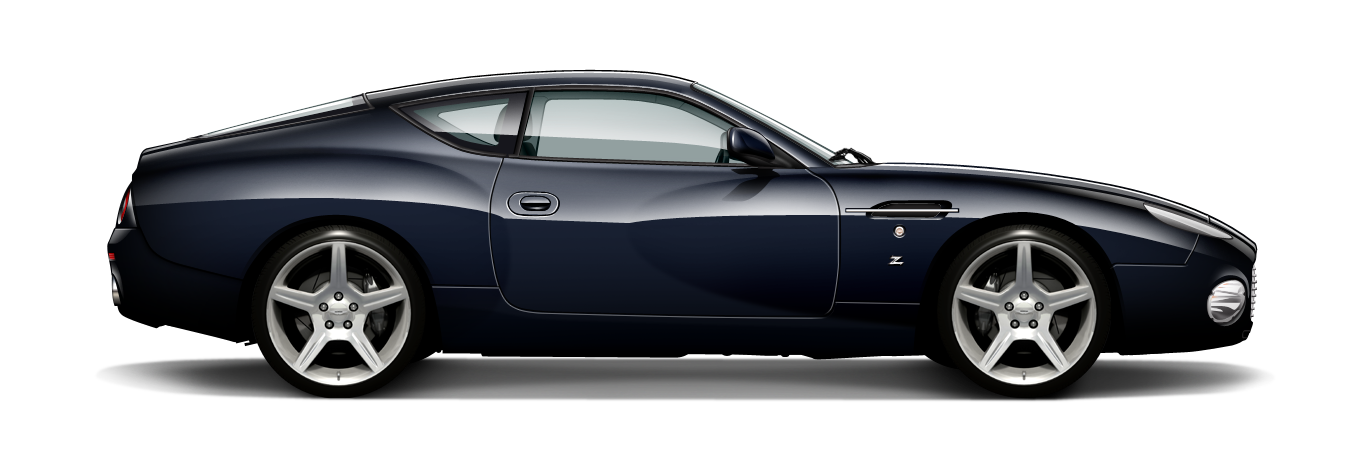
STORY
By 2002 the nearly-ten-year-old DB7 was showing its age. It had already received a V12-engine transplant and body and interior modifications, but it was coming to the end of its lifecycle. To retain interesting the model until its successor arrived, Dr Ulrich Bez (former CEO) announced at that year’s Geneva Motor Show that Aston Martin would be producing two new DB7’s, both with Zagato designed bodies.
The project had its orgins at the 2001 Pebble Beach Concours d’Elegance when Bez found himself seated next to Dr Adrea Zagato at the judges table. Over dinner on Sunday 19 August Bez broached the subject of renewing the celebrated collaboration with Zagato.
Initial sketches by Zagato’s Chief Designer Norihiko Harada were presented to Bez and Aston Martin’s new Design Director Henrik Fisker shortly after. During the Frankfurt Motor Show the brief was agreed and in December, further more detailed designs were shown to Aston Martin personnel. Final approval to proceed was given in early 2002.
The prototype, named ‘Georgia’ by the project team, was crafted in hand-beaten aluminium at Zagato’s studios in Milan.
Back at Bloxham, ‘Georgia’ and three additional engineering cars were thoroughly road tested and developed. The new exterior styling was only the beginning of a large number of changes the DB7 went through to bring it to market.
The Zagato was powered by the DB7 Vantage-derived V12 engine and some other mechanical components were carried over as well. Unique features included an up-rated 435 bhp engine, improved brakes and suspension and a higher differential ratio of 4.09:1 was used for quicker acceleration. Manual transmission only was offered. The front and rear suspension utilised double aluminium wishbones and coil springs with unique dampers developed to create more driver-centred car.
The design owed little to the original. Save for the front windscreen, every panel was different. Lightweight aluminium was used for the bonnet, doors and boot, with pressed steel used for the front wings and roof, while the front and rear bumpers were constructed from impact absorbing composite material.
Harada’s design married both Aston Martin and Zagato styling features in a dramatically different-looking car. Based on a shortened DB7 Vantage Volante chassis, the front and rear overhangs were abbreviated by 0,5 inches and 8 inches respectively, creating a car 2,5 inches shorter in the wheelbase and 8 inches shorter overall, while being 1 inch wider and marginally taller. The famous air vents remained and Aston Martin’s trademark grille was apparent, bit it was enlarged in the Italian style like numerous past Maserati and Ferrari sports cars.
Zagato’s styling cues were also in abudance with the famous double-bubble roof, up-swept rear quarter glass, short front and rear overhangs, muscular rear haunches and taut body panels. The grille-shaped rear featured a small luggage slot, reminiscent of the DB2, and new round rear taillights. Of particular note was the rear glass, which continued the ‘double-bubble’ effect of the roof.
Only three standard colours were offered – Aqua Verde, Zagato Nero and Mercury Grey – however, many customers ordered bespoke colour schemes. Eventually 28 different body colours and 19 interior combinations were chosen.
Unlike previous Aston Martin-Zagatos, whose rolling chassis were constructed in England then transported to Zagato in Milan where the aluminium bodies were fitted, the DB7 version had pressed panels constructed by Italian company OPAC. The body shells were then phosphated and electroplated by Padanaforesi and primed by Rattalino in Italy before returning to Gaydon where they were painted. The cars were constructed at Bloxham, each taking around 250 hours to complete.
The interior retained the DB7 Vantage steering wheel and most switch gear, but featured quilted, Zagato-embossed aniline leather seats. The dashboard and doors, reconfigured to compensate for the car’s higher waistline, were trimmed in matching leather. A parcel shelf, complete with leather straps, replaced the rear seats, providing additional luggage space.
To highlight the Zagato’s bespoke nature, a Mercury Grey model with chocolate brown interior, chassis number AB3400008, was officially unveiled to a gathering of 120 potential customers at the famous London tailors Gieves and Hawkes, at Number 1 Savile Row in July 2002.
The DB7 Zagato was also previewed at the 2002 Pebble Beach Concours d’Elegance on 18 August and made its motor show debut at the Paris Salon on 28 September 2002.
Interest was strong and Aston Martin announced in October 2002 that 200 confirmed orders had been taken. Production however was capped at 99: chassis numbers 700001 – 700099. One additional car was retained by the factory.
Source & copyright note: from the book ‘Power, Beauty and Soul’ written by the author David Downsey (obtained with permission). None of the text above may be used without the prior written permission of the rightful author, including copying, duplicating, printing, publishing (even on a website), reproducing, storing, or transmitting by any means what so ever.




